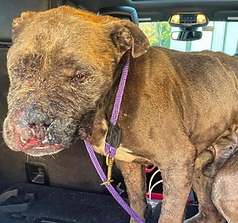Kellan Kissinger
ENC 4218 Ethics of Visual Representation Project
Introduction
"What is means to be a "pit bull" began to change in the United States at the start of the twenty-first century. What has been widely regarded as the categorical "bad dog" started to shift into a being deserving of care and concern, one who had a place in city life and the family home."
- Harlan Weaver, Bad dog: pit bull politics and multispecies justice
What even are "pit bulls"?
The term "pit bull" is a specific categorization or idea of dogs rather than a specific type of breed or animal. According to Weaver, it generally refers to a "squat, muscular, short-haired dog with forward flopping ears, anywhere between 30 to 150 pounds in weight." It seems quite obvious that this definition applies to a great number of dogs. These
dogs also are accompanied by a largely negative reputation, with people saying "'Don't call me
when one of the kids get mauled'" (Bill). This change has largely occurred over the last half
century, as the dog has gradually become "America's most feared dog" (Bill). But this wasn't
always the case.
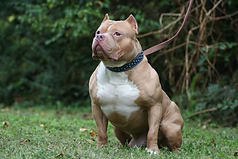
In the past, the pit bull was actually considered "America's dog" (Bill). From Sergeant Stubby, a dog who served in World War I and was promoted to sergeant by his commanding officer, to Petey, the lovable dog featured on the hit TV show "Little Rascals," pit bulls have shown themselves to be loving, responsible, and talented dogs. So, when did the shift towards pit bulls having a "bad rap" actually begin and what facilitated this change in the visual representations of these animals?
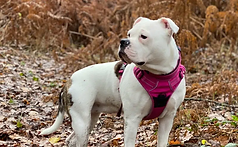
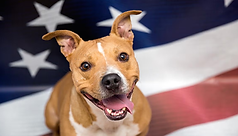
Fig. 5-7. Depiction of the variety of appearances that can be categorized at a "pit bull."
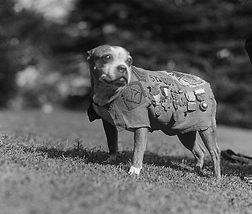

Fig. 8-9. Sergeant Stubby (left) and Petey (right), positive role model pit bulls
Where does the bad rap come from?
Pit bull's negative reputation is largely linked to two factors: their history of being the preferred dogs in the practice of dog fighting and aggressive and violent incidents resulting from pit bulls biting or mauling people, most notably children.
Stories of a "5-year old boy need[ing] 2,000 stitches to repair his wounds when a pit bull burrowed into his backyard in Colorado Springs in May and attacked him" (Bill) or a "husband [being] chased into their home by two pit bulls that were later euthanized as dangerous animals" (Bill) poison the well and make everyone believe that all pitbulls are dangerous and violent but this simply not the case. According to Lauren Fox, the director of Colorado Springs All Breed Rescue & Training, pit bulls will "be whatever you want them to be. [...] They want to please you whether you're training them for good and evil. They're moldable dogs" (Bill). What this means is that pit bull's behavior, including the violent behavior they are associated
with, is primarily determined by their owner.
This mouldability was a huge reason why pit bulls were one of the chosen breeds of dog fighters. Dog fighting can be traced back to the early 1800s in the UK where pit bulls were used in a cruel sport called bull or bear baiting. This sport involved setting one or two dogs on a bull or bear for hours until the bull/bear or dog(s) collapsed from injury or fatigue ("The History of Pit Bulls"). After bull and bear batting was outlawed in 1835, these dogs were used in another sport, ratting. Ratting refers to the practice of pitting multiple dogs against rats in a "pit" and seeing whose dog could kill the most rats in the least amount of time. And of course, there was also the practice of setting two dogs off on each other in the practice of "dog fighting," which is probably the most well known of the sports pit bulls were involved in. Dog fighting was outlawed in the US with the 1976 amendment to the Animal Welfare Act of 1966, which made dogfighting and possessing dogs for the purpose of dog fighting a felony in all 50 states. Unfortunately, in the 1980s dog fighting began to reemerge, and people began to seek out pit bulls for illicit purposes again ("The History of Pit Bulls").
Still, pit bulls are not inherently violent even with their history like some depict them. In fact, due to all of the sports pit bull type breeds were involved in, they were actually selectively breed to encourage bite inhibition towards humans so that the handlers could be sure they could enter the pit and avoid the danger of being bit themselves. Many well know historical figures and celebrities also had pit bulls as pets, including "Helen Keller, Theodore Roosevelt, Thomas Edison, and Mark Twain" ("The History of Pit Bulls"). Today, pit bull's are receiving more and more positive attention even in the face of so much negativity.
Fig. 10. Unfounded news headline from the City Journal claiming that pit bulls "can wreck a neighborhood's quality of life," likening the dog's effect to prostitution and drug dealing.
Fig. 11. Photograph of dog attack victim in the hospital after surgery, paired with a photo of an aggressive looking pit bull in a Newsweek article.
Scope & Purpose
The scope of this project will focus on visual representations of pit bulls within the US, even though the history of pit bulls begins in the UK. By comparing and contrasting how negative news, social media, entertainment, and advocacy visually represents pit bulls to how shelters and rescue organizations spread awareness through positive representations, I hope to display how pit bulls have been unfairly categorized as violent, aggressive, and mean dogs. This project is dedicated to my dog, Zen, a pit bull whom my family adopted from the animal control shelter in my hometown. Zen, true to his name, is the sweetest, laid back dog and would never hurt a soul even though he faced rampant abuse from his previous owners. I hope that this project will show how most pit bulls are just like Zen, dogs that were molded to be something they're not by bad people.
Fig. 12. Photo of a "bait dog" used in dog fighting with a healed severe injury.
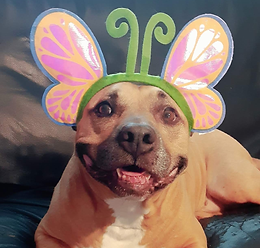
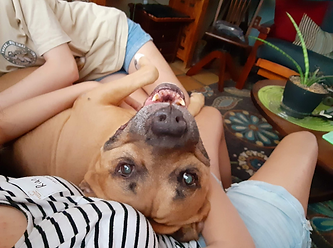

Fig. 13-15. Photos of my dog, Zen.


